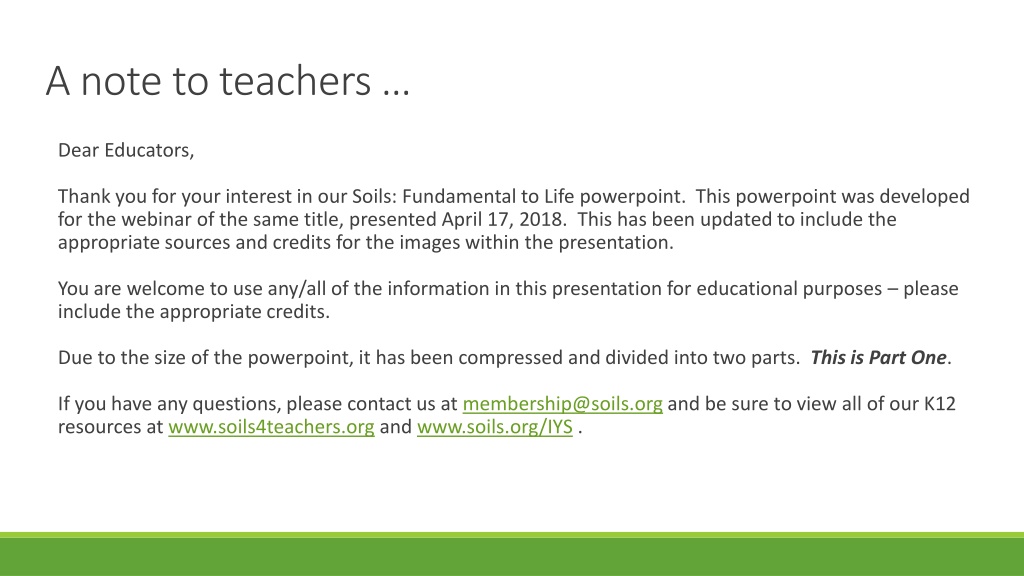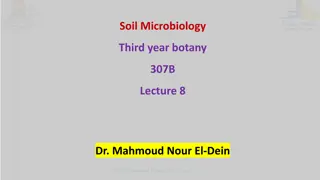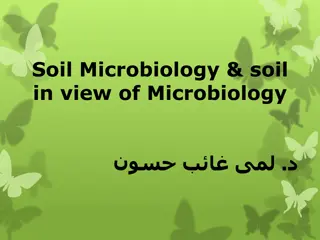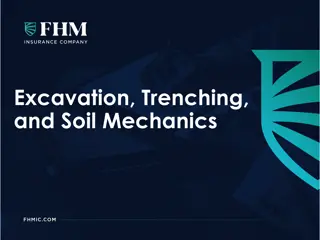Exploring the Importance of Soil in Education
Gratitude to educators for their interest in the "Soils: Fundamental to Life" webinar presentation. The presentation emphasizes the significance of soil in ecosystems, featuring renowned speakers and informative content. Sponsored by NESTA, the session aims to enhance Earth and Space Science education through online resources and professional development opportunities. Teachers are encouraged to utilize the educational materials provided to inspire students' curiosity about the Earth and its resources.
Download Presentation

Please find below an Image/Link to download the presentation.
The content on the website is provided AS IS for your information and personal use only. It may not be sold, licensed, or shared on other websites without obtaining consent from the author. Download presentation by click this link. If you encounter any issues during the download, it is possible that the publisher has removed the file from their server.
E N D
Presentation Transcript
A note to teachers Dear Educators, Thank you for your interest in our Soils: Fundamental to Life powerpoint. This powerpoint was developed for the webinar of the same title, presented April 17, 2018. This has been updated to include the appropriate sources and credits for the images within the presentation. You are welcome to use any/all of the information in this presentation for educational purposes please include the appropriate credits. Due to the size of the powerpoint, it has been compressed and divided into two parts. This is Part One. If you have any questions, please contact us at membership@soils.org and be sure to view all of our K12 resources at www.soils4teachers.org and www.soils.org/IYS .
Soils: Foundation for Life a K-12 Educators Webinar SPONSORED BY SSSA AND NESTA
This session is sponsored by NESTA A member-run, non-profit supporting the teachers of Earth sciences at all levels and helping fuel the passion for the Earth and beyond Facilitate and advance excellence in K-12 Earth and Space Science education, serving a diverse population of learners in formal and informal settings Work and for teachers by providing Online resources for NGSS-ESS and the Frameworks Professional Development through webinars and workshops at NSTA Quarterly peer-reviewed journal, The Earth Scientist, monthly E-news Internet Presence nestanet.org
NESTA Internet Presence Website http://www.nestanet.org News and Announcements Professional Development Teaching Resources Educational Advocacy Join our Facebook Group and actively participate in the community https://www.facebook.com/group s/nationalesta/ Follow us on Twitter @NESTA_US https://twitter.com/NESTA_US
Our Speakers Soil Characteristics Soil Overview Soil Formation Soil Fertility Clay Robinson David Lindbo Wale Adewunmi Rachel Leege Associate Professor of Soil Science, Illinois State University Director, Soil Survey Division, USDA- NRCS Soil and Environmental Scientist, Consultant Manager of Student Programs, Soil Science Society of America Soil Science Society of America
What is soil? Soil is the foundation for all terrestrial ecosystems, and because it is always underfoot, it is almost always overlooked, and too often underappreciated. Photo Credit: Clay Robinson Soil Science Society of America
Soil Intersecting All Spheres on Earth Credit: Know Soil, Know Life book/Soil Science Society of America Soil Science Society of America
Soil: Intersection of Atmosphere Biosphere Pedosphere (soil) Lithosphere Hydrosphere Photo Credits: Clay Robinson Soil Science Society of America
Soil Is not dirt (under fingernails or on carpet) Is a natural resource (slowly-renewable) Is diverse, heterogeneous, dynamic Supports life: microbes, plants, animals Is important in the hydrologic cycle and water quality Used for roads and buildings Used for cultural activities (pottery, paints, dyes, etc.) Different things to different people A quick online search easily yields more than 15 definitions! Soil Science Society of America
Is there soil on the moon or other planets? Recently the Soil Science Society of America changed their definition of soil to allow the material at the surface of other planets to be considered soil, even though things aren t growing in it, or it may not have water in it. Last year, I would have said no, but now I have to say yes! A soil scientist has been working with NASA for years with the Mars Rover Project! Mars Curiosity Rover Photo Credit: NASA Soil Science Society of America
Soil is an applied science that uses Chemistry - how things are made Physics - how things move and work Biology - how things live and grow Hydrology - how water cycles through the soil-atmosphere systems, and where it is stored Ecology - how all these systems affect plant and animal communities Geology - how the minerals may affect soil properties Soil Science Society of America
Soil forms from the surface downward by Additions Water percolates through soil Plants grow at the surface Translocations Particles and minerals move down within the profile Transformations Minerals are changed Losses Erosion Leaching Source: Soil! Get the Inside Scoop. Credit: Diagram based on N.C. Brady and R.R. Weil, 2008. The Nature and Properties of Soil. 14thEd. Prentice Hall, Upper Saddle River, NJ. Soil Science Society of America
Soil Formation Processes Additions Water percolates through soil Plants grow at the surface Translocations Particles and minerals move down within the profile Photo Credit: Clay Robinson Soil Science Society of America
Soil Formation Processes Translocations Particles and minerals move down within the profile Transformations Minerals are changed Photo Credit: Clay Robinson Soil Science Society of America
Soil Formation Processes Losses Erosion Leaching Left & Right Photo Credits: Clay Robinson; Middle Credit: Wikimedia Commons Soil Science Society of America
Additions Photo Credit: David Lindbo Soil Science Society of America
Source: Soil! Get the Inside Scoop, SSSA Soil Science Society of America
Poll Question! What fraction of earth's land is suitable for agriculture? Soil Science Society of America
Starting with an apple Water covers 75% of Earth. So is not water Of that: is polar ice caps, mountain ranges of = Of that, has a soil or climate problem of of is potentially arable Soil Science Society of America
THE SOIL FROM CL.O.R.P.T. Factors of Formation or Why do soils look different Soil Science Society of America
Factors of formation Climate Organisms Relief Parent Material Time Soil Science Society of America
The soil forms through the interaction of these factors. Soil Science Society of America
Climate TEMPERATURE, RAINFALL, ETC. Source: Soil! Get the Inside Scoop, SSSA Soil Science Society of America
Importance TEMPERATURE PRECIPITATION Dissolves materials Plant growth Type Quantity Plant growth Type Quantity Biological activity Decomposition Mineralization Biological activity Decomposition Mineralization Evapotranspiration Translocations (leaching) Chemical reactions A 10oC rise = 2-3x increase in reaction Transformation (chemical reaction) Physical reactions freeze-thaw Erosion Soil Science Society of America
Precipitation-Temperature Relations Hot Dry Desert Cold Dry Antarctica Hot Wet Tropics Cold Wet Northern Canada Micro-climate Aspect Air drainage Elevation Soil Science Society of America
Poll Question: Where are the soils with the highest amount of organic matter? Soil Science Society of America
Climatic Differences Photo Credits: David Lindbo Warm - Humid Warm - Dry Soil Science Society of America
Organisms AKA VEGETATION OR BIOLOGY Soil Science Society of America
Organisms Plants Grasses Coniferous Deciduous Animals Burrowing Grazing Micro- and Meso-organisms Bacteria Fungi Worms, Insects Photos: Adobe Stock Soil Science Society of America
Biological mixing or Bioturbation Tree Throws Crayfish Burrows Ant Hills Photo Credits: David Lindbo Rabbit Warrens Soil Science Society of America
Vegetation Maple Hemlock Grassland O&A E O&A Bhs BC, CB Bt BC, CB Ck C Photo Credits: David Lindbo C Soil Science Society of America
Relief AKA TOPOGRAPHY Soil Science Society of America
Relief, Topography or Slope Degree of slope erosion, stability Location on the slope water relations Source: Soil! Get the Inside Scoop, SSSA Soil Science Society of America
100 cm Measuring slope 5 cm % Slope = (5cm 100cm) x 100 % Slope = 0.05 x 100 Image Credit: David Lindbo % Slope = 5% Soil Science Society of America
Relief slope, shape, aspect Profile thickness OM content and thickness of A Wetness Color Horizon expression Chemistry (pH, base saturation, salts) Temperature Soil Science Society of America
Slope Position Names Summit Shoulde r Side or back slope Foot slope Photo Credits: David Lindbo Toe slope Soil Science Society of America
Parent Material SOILS HAVE PARENTS TOO! Soil Science Society of America
Parent Material Transported materials Bedrock or residual material Organic materials Source: Soil! Get the Inside Scoop, SSSA Soil Science Society of America
deposited in wet areas TRANSPORTED Parent Materials ORGANIC Parent Materials Plants deposited in lakes Lacustrine Alluvial (fluvial) deposited by streams deposited in or by oceans Marine RESIDUAL Parent Materials gravity transported Colluvial Till: basal, ablation, deposited by ice formed in place Sediment transported Outwash, Lacustrine Alluvial Marine wind Credit: David Lindbo Rocks Aeolian (Eolian) Soil Science Society of America
Organic ACCUMULATION OF PLANT AND ANIMAL DEBRIS GENERALLY IN WET ENVIRONMENTS Photo Credit: David Lindbo Soil Science Society of America
Residual Materials WEATHERED AND FORMED IN PLACE Photo Credits: David Lindbo Soil Science Society of America
Transported Materials MATERIALS THAT HAVE MOVED AND THEN WEATHERED Soil Science Society of America
Source: Know Soil, Know Life; SSSA Soil Science Society of America
Water Transported Ice Transported Water Transported Ice Transported MARINE LACUSTRINE GLACIAL TILL GLACIAL OUTWASH FLUVIAL Source: Lower Left-The Photo Gallery & Aerial Graphics, LLC; Upper right-Adobe Stock; all others David Lindbo Soil Science Society of America
Wind Transported Wind Transported Source (L to R): Soil! Get the Inside Scoop, SSSA; USDA-ARS; http://www.pik- potsdam.de/~stock/lectures/earths_climate_ruddiman/ch13- the%20last%20glacial%20maximum/figure%2013-06.jpg; USGS Soil Science Society of America
Time DEGREE OF SOIL FORMATION Source: Soil! Get the Inside Scoop, SSSA Soil Science Society of America
Degree of Development Degree of Development Hot Dry Desert SLOW Cold Dry Antarctica SLOW Hot Wet Tropics FAST Cold Wet N. Canada SLOW Time in soil formation is also relative Soil Science Society of America
Photo Credits: David Lindbo Young few horizons Older - more horizons Soil Science Society of America
Poll Question! How long does it take to form an inch of soil? Soil Science Society of America























